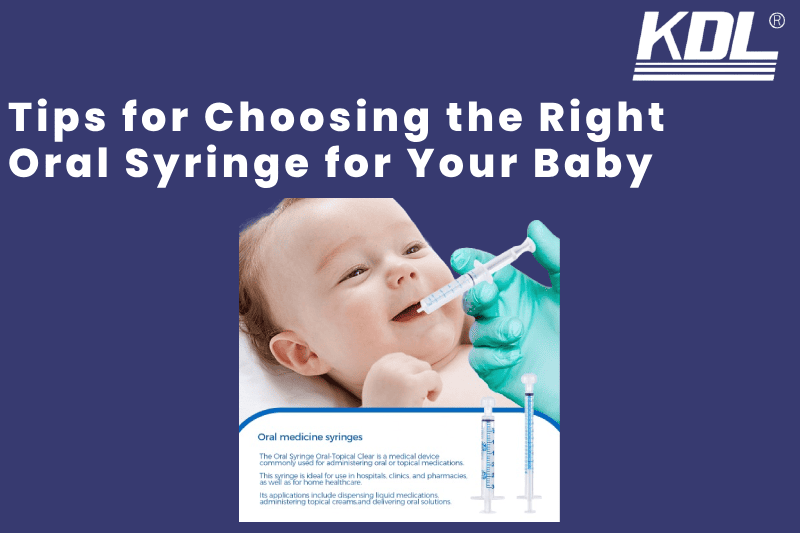
When it comes to administering medication to your baby, choosing the right oral syringe is crucial. With a myriad of options available, it’s important to select one that is safe, accurate, and easy to use. In this guide, we will provide you with valuable tips for selecting the perfect oral syringe for your baby’s needs, ensuring precise and stress-free medication administration.
What is Oral Syringe?
An oral syringe is a device designed for administering liquid medications orally. It typically consists of a plastic tube with volume markings, a plunger, and a tip or nozzle for dispensing the liquid. Unlike traditional syringes used for injections, oral syringes do not have a needle.
Oral syringes are commonly used for accurate and controlled dosing of liquid medications, especially for individuals who may have difficulty swallowing pills or for administering medications to infants and young children. The volume markings on the syringe help ensure that the correct dosage is measured and administered.
How to Use a Baby Oral Syringe
Medicating your baby can be a delicate task, necessitating precision and care. In this article, we’ll explore the ins and outs of utilizing an oral syringe, shedding light on the essential steps that ensure a safe and effective medication administration process.
Distinct features of baby oral syringes
Baby oral syringes, with their unique design, offer a specialized approach to medication administration for infants. Unlike conventional syringes, these devices are crafted with the delicate needs of babies in mind, featuring finer calibration for precise dosage control.
Factors to consider when selecting an appropriate Baby Oral syringe size
Selecting the right size is paramount. Consider the volume of medication prescribed and the baby’s age to determine the appropriate syringe size. Opting for a syringe that matches the prescribed dosage ensures accurate administration and minimizes the risk of over or under-dosing.
Preparing the Medication Syringe for babies
Reading and interpreting medication instructions
Before delving into the administration process, decipher the medication instructions meticulously. Understanding the prescribed dosage, frequency, and any specific guidelines is crucial. Clarity in interpretation sets the stage for a smooth and effective administration.
Proper assembling and cleaning of the baby oral syringe
Assemble the oral syringe in accordance with the manufacturer’s guidelines, ensuring each component fits snugly. Prior to each use, employ thorough cleaning techniques, using a mild detergent and warm water. A pristine syringe guarantees the purity of the medication and reduces the risk of contamination.
Read More : The Ultimate Guide to Using an Oral Syringes for Medication Administration
Creating an Optimal Administration Environment
Importance of a calm and distraction-free space
Creating a conducive environment is an often overlooked yet critical aspect. Choose a quiet space with minimal distractions to foster focus during the administration process. A serene environment facilitates a seamless experience for both the parent and the baby.
Ensuring baby’s comfort and cooperation during the process
Comfort is synonymous with cooperation. Prioritize your baby’s comfort by ensuring a gentle and supportive hold. A relaxed baby is more likely to cooperate during the administration, transforming the process from a task to a shared moment of care.
Administering Medication Effectively
Techniques for precise insertion of the syringe
Mastering the technique of inserting the syringe is an art. Aim for the side of the baby’s mouth to avoid the gag reflex, and insert the syringe gently yet purposefully. Precision at this stage contributes significantly to the overall effectiveness of the administration process.
Ensuring a controlled and gradual medication delivery
Avoid haste in medication delivery. Gradually dispense the medication, allowing the baby sufficient time to swallow. A controlled approach not only minimizes the risk of choking but also enhances the likelihood of successful administration.
Overcoming Challenges
Addressing resistance and fussy behavior
Resistance is commonplace, especially with infants. Employ various strategies to handle resistance, such as using soothing tones, engaging in gentle distraction, or introducing a comforting item during the process. Adaptability is key to overcoming these challenges.
Troubleshooting common issues during baby oral syringe use
In the face of issues like blockages or difficulties in administration, familiarity with troubleshooting techniques is invaluable. Refer to the manufacturer’s guidelines for quick and effective solutions, ensuring a seamless experience for both the parent and the baby.
Tips for Choosing the Right Oral Syringe for Your Baby
Selecting an oral syringe may seem like a simple task, but its implications on your baby’s well-being are profound. A suitable oral syringe not only facilitates accurate medication administration but also contributes to your baby’s comfort during the process.
1. Safety Considerations
Prioritizing safety is paramount when choosing an oral syringe for your baby. Opt for syringes made from safe, non-toxic materials that are free from chemicals like BPA, ensuring the absence of harmful substances that could potentially affect your baby’s health.
2. Accuracy in Measurement
Accurate dosing is critical when it comes to your baby’s medications. Choose a syringe with clear and easily readable graduations, enabling precise measurement for even the smallest doses, ensuring your baby receives the correct amount of medication.
3. Ease of Use
An oral syringe that is easy to handle and maneuver is beneficial for parents. Look for features such as a smooth plunger and a transparent barrel that allow for effortless administration and clear visibility of the liquid medication.
4. Hygiene and Cleaning
Maintaining proper hygiene with oral syringes is essential to prevent contamination and infections. Select syringes that are easy to disassemble and clean thoroughly, ensuring a safe and germ-free environment for medication administration.
5. Compatibility with Medication
Different medications may have specific requirements for administration. Consult with healthcare professionals to ensure the syringe you choose is compatible with the type of medication your baby needs, preventing any adverse reactions or issues.
6. Comfort for the Baby
Consider the comfort of your baby during medication administration. Opt for syringes with features like a rubber-tipped plunger that provide gentle contact with the baby’s mouth, enhancing their comfort during the process.
7. Consultation with Professionals
When in doubt, seek guidance from pediatricians or pharmacists. Their expertise can assist in selecting the most suitable oral syringe tailored to your baby’s unique needs and any underlying health conditions.
8. Additional Features and Considerations
Explore extra features such as locking mechanisms for added safety or size variations to accommodate varying doses. These additional features can contribute to a smoother and safer medication administration process.
Conclusion
In conclusion, the importance of choosing the right oral syringe for your baby cannot be overstated. By considering factors such as safety, accuracy, ease of use, and compatibility with medication, you can ensure a seamless and safe experience for your baby during medication administration, contributing to their overall well-being. Always prioritize consultation with healthcare professionals to make an informed decision and provide the best care for your little one.

